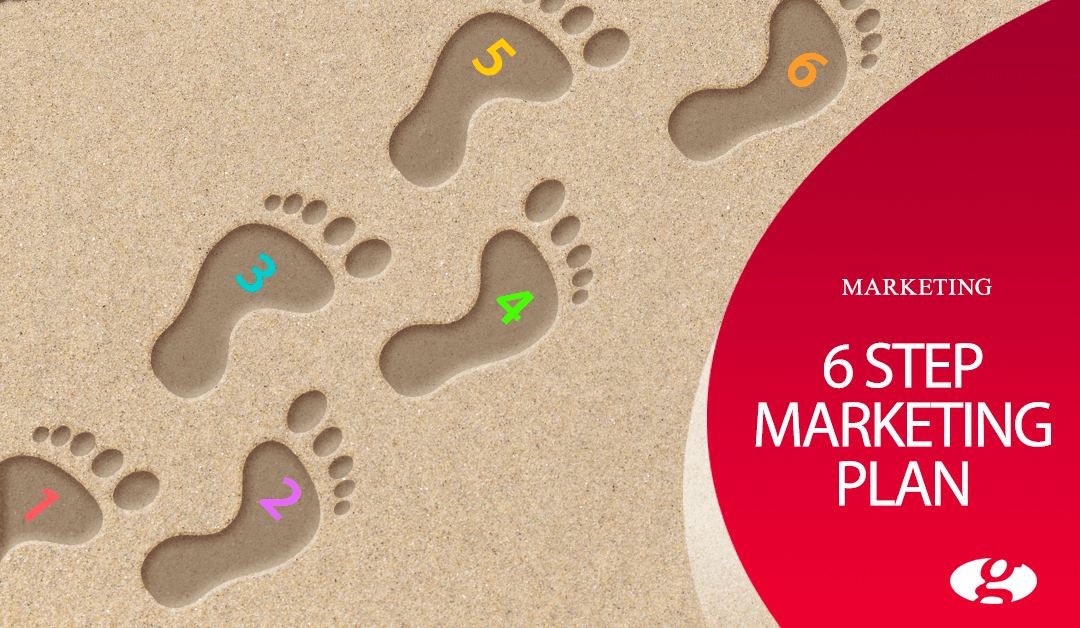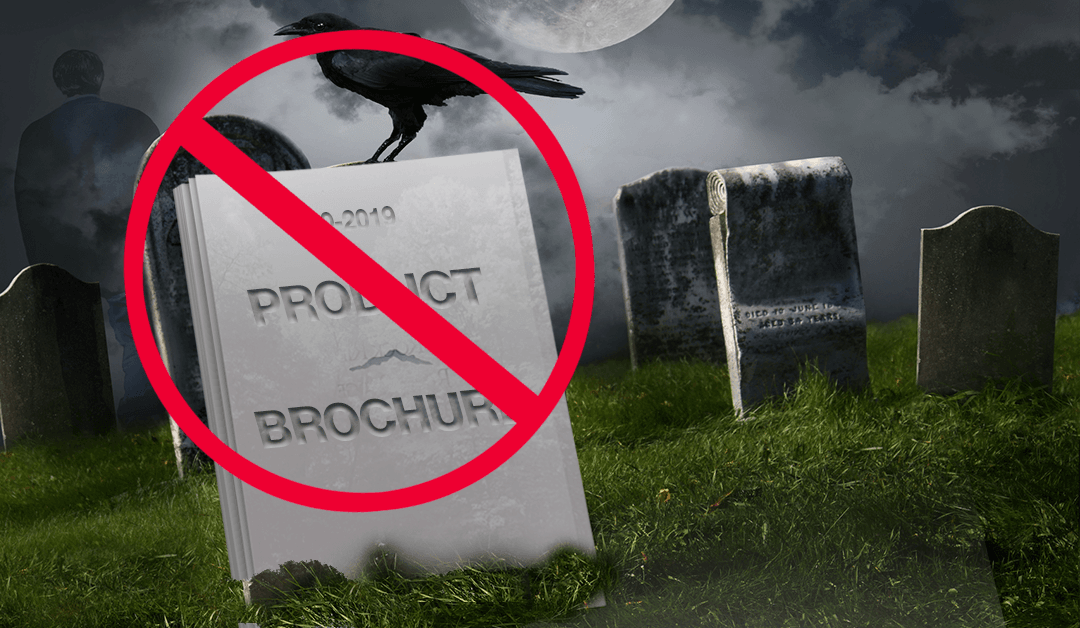March 15, 2022

It’s not too late for 2022 marketing planning. It’s easy to create a plan based on goals, data and statistics from the marketing tactics from last year. It will be a little more challenging if this is your first plan, but these tips will help in both instances.
6 steps:
1) Establish Marketing Goals
A marketing plan needs to be rooted in goals. The goals become your focus for all marketing-related activities. You’ve likely heard of SMART goals, and this is definitely one of the times to implement the SMART goal approach. For example, instead of jotting down a goal of increasing website traffic, think instead of a goal structured like this: Increase net new visitors to the company website by 8% (compared to 2021) by October 2022.
If your business is focused on a specific product or service in 2020, then your goal might change to focus on increasing net new visitors to that product or service page instead. The point is that the goals should have parameters and a way to determine whether or not the goal has been achieved.
2) Look At The Data
Now that goals have been established, it’s time to look at the data from past marketing activities. For example, if email marketing is part of your 2021 plan, it’s time to review the stats from email campaigns. If social media is part of your marketing, analyze the data. The idea here is to understand what worked and what didn’t in 2021. What worked means that it helped your business achieve its marketing goals!
If your business didn’t set marketing goals, last year or data is not available, that is something to work on this year. Meaning one of your goals may be to implement email marketing analytics for all emails deployed in 2022 by leveraging an email marketing tool with built-in analytics before sending the first email. You get the idea. Analytics are essential because they help to show success with complex numbers. These hard numbers enable you to determine where to focus your time and budget.
3) Determine The Budget
Yep, it’s the budget question. It may make people squeamish about talking about budget, but it is a necessary question. Without a budget, it is hard to know where to spend and how much to spend. Without a budget, your business may be out of marketing cash in June or have a surplus in November…neither one of these scenarios is good.
Identify the marketing budget, and have a clear understanding of what comes out of that budget. Once there is a clear understanding of the available budget, you’ll be able to allot that budget appropriately by aligning it with your goals and data. Also read about our marketing budget rule of thumb.
If we go back to our original SMART goal of increasing net new web visitors, we know the budget should be spent on driving traffic. However, if we bump that goal up against our analytics, we may find that email marketing drove most traffic to our website. Knowing these two components enables us to earmark a good portion of our budget for email marketing and to grow our email marketing lists.
It’s a logical approach, which is helpful when it comes to spending marketing dollars.
4) Talk To Sales
Marketing and sales need to work together, and the best way to begin the process of working together is to understand the goals of the sales team, and how marketing can support them. This also gives you an opportunity to pick their brains! What are they hearing from customers and prospects, what has helped them close a sale faster or start a conversation, what do they know about the competition? The sales team has insights, and it is vital to understand them and create a unified front.
5) Draft The Plan
You’ve collected all of the details, and now comes the fun part, developing the marketing plan! The format of the plan is not as important as the content of the plan. The marketing plan should include your marketing goals, strategies, tactics, forms of measurement, and budget allocation. It should also highlight how often the plan will be reviewed. A marketing plan should be a bit fluid and enable you to reallocate the budget if a tactic is not performing IE., not helping to reach the SMART goals). If the plan needs to be adjusted, don’t sweat it; embrace it. It’s better to change mid-way through the year than look back after 12 months and realize goals were not met.
6) Incorporate Testing
Testing marketing tactics is a critical component that must not be forgotten. Testing enables you to try new tactics within your marketing plan/budget with minimal risk. For example, let’s say you are starting to see a decline in email marketing metrics mid-way through the year. Rather than stay the course, use some of the budgets you allocated for testing to try Google Ads, LinkedIn Ads, or another form of marketing that is not currently in your plan. And since it is a test, you are leveraging a small portion of the budget within a specific time frame to gauge whether or not it is worth investing more time and potentially reallocating the budget to the “new” tactic.
As you can tell, we believe in marketing planning. It provides a road map and a clear approach to the coming year.
Learn more about our Strategic Marketing Services. Need any help with your 2022 small business marketing planning? Contact us and let’s start the conversation. Happy planning!
This is a guest post from Kristen Davis, CEO & Founder of Athenian Marketing.
February 24, 2022

Guest post: Kristen Davis, CEO & Founder of Athenian Marketing.
Marketing is an investment in your business and is not an expense. So how much should an organization invest in marketing? Unfortunately, there isn’t a hard and fast number that every business should adhere to because each company is different, and every business is in a different marketing stage. But, if you need a “rule of thumb,” we recommend allocating 5-10% of your gross revenue to marketing. The range is in place because there are several factors to consider when determining a marketing budget, so a hard and fast number is a challenge. Let’s look at the factors that impact how much your business should allocate for marketing.
Foundational Elements
Foundational marketing elements include your brand, website, a marketing plan, literature & social media platforms. Think of foundational elements as the basis of your marketing plan. Without them, it will be hard for your marketing to be consistent and won’t provide your customers, or potential customers, with a focused view of your business.
If you do not have your foundational marketing elements in place, plan to allocate additional funds to marketing to establish those foundational elements.
Brand Awareness
Once your foundational elements are in place, take a look at your brand awareness with your target audience. Does your prospective customer know about your business? If your answer is no, or you aren’t sure, you’ll want to allocate a more significant percentage of funds to your marketing budget. Building up your brand awareness paves the way for new customers to recognize your brand and your business and make the conscious decision to buy from you.
Think about some of the specific brands you know. They didn’t get there by shying away from spending on their brand awareness. They got there by marketing their brand to their target audience. Focusing on brand awareness is essential regardless of business size. Remember that you don’t need everyone to know about your business. You need your target audience to know about your business. That is where the focus should be. Check out our “Whats Your Brand Identity?” post.
Events and Tradeshows
If events and tradeshows are part of your marketing budget, be aware that they can eat up a large chunk of your budget and may not provide the dividends needed to reach your goals. Think booth costs, team travel, team hotels, shipping materials, and more.
Now that we’ve outlined factors that can impact your budget, how do you decide how to divvy up the budget? That’s where your marketing goals come in. What are the marketing goals for the coming year? So before determining a budget, determine your goals. (If you need a little help, check out our Marketing Planning blog post!)
Once goals are determined, determine approaches to help your organization meet those goals, and then put numbers to the strategy.
But what if you misallocated the budget? Not to worry. Since marketing is trackable, scalable, and can be layered. Thus, effective strategies can constantly be enhanced or modified to capture new or different audiences. Isn’t marketing great!
If you face the budget conversation in your business and need a bit of help wading through the details, give us a call. We’d be happy to talk through the details and give you a few pointers.
This post is from Kristen Davis, CEO & Founder of Athenian Marketing.
February 22, 2022

Take a minute to count all of the electronic devices in your home, including phones, computers, and tablets. The digital age is booming. But is print marketing still effective and profitable? What are the benefits of promoting brands on the glossy pages of trade publications or with brochures, posters, and postcards? Even if print is still a viable option, how do you know if it is suitable for your company?
We strongly believe that many brands have a great deal to gain from print advertising. It can be a substantial complementary marketing channel to all digital and other traditional campaigns. So let’s take a look at how print can help you develop a strong relationship with your customers.
The Meet-Cute: Make a more tactile impactful introduction and first impression.
Anyone can find pretty much anything on the internet if they know how to look for it. An excellent digital campaign can put your brand in front of a customer even if they don’t type the exact words used to describe your company. However, those search result pages can be cluttered with a lot of images and information. Finding a perfect match in a noisy crowd can be very difficult. Print gives companies captive readers who spend longer looking at published pages than digital sites.
With print, a customer has a chance to meet your brand and get a more tangible feel for who you are for a company before they go online. Aligning your brand with trade information or special interests helps readers to identify with your products and services in a way that relates directly to their wants and needs. Also, studies have shown that a reader being able to feel a page in their hands provides a more lasting experience than viewing an article on a screen.
The scope and depth of all digital marketing opportunities can be overwhelming and confusing, especially if you’re a small business or new to the digital playing field. For companies wanting to keep things simple, print, in all its many avenues, can feel much more familiar. Having a sales executive or team dedicated to responding to inquiries and requests obtained from the print promotions can allow you to see immediate results.
Friends First: Take the opportunity to hang out with your customers for a while.
A website can be gone with one click, but we’ve all got those magazines and brochures that just seem to linger for a while before heading to the recycle bin. They pile up on a bookshelf, side table, or the corner of our desk. The pages within those publications are windows to potential customers; subtle, casual ways to reach readers with no pressure. Creating a “coffee table piece” puts you in the middle of that person’s life without an overwhelming attack of cold calling and emailing.
Developing your brand with a customer in an organic way can help that customer to feel more comfortable approaching your company for information and ultimately making a purchase. Sometimes, a brand can come on too strong with a barrage of digital ads and sponsored social media posts, causing a customer to block all of your promotional materials. Each time a reader flips through a magazine or publication, your ad will be right there in a reassuring way. They may choose to turn the page, but even a glimpse can leave an impact.
Also, unlike the never-ending search result pages of the internet, your brand will not be displayed next to a half dozen other companies. When a customer, potential or current, sees your marketing message in print, the images and words on the page get the final say in that interaction.
A Foundation of Trust: Add extra print marketing touches to campaigns to build a stronger relationship.
As of Q4 of 2018, Stanley Black & Decker had the largest portion of the market share for power tools. The next largest market shareholder sold almost an entire $1 Billion less than B&D. Despite being the top-selling and one of the most well-known brands within their industry, you can find ads for Black & Decker Power Tools within the pages of many different publications, in addition to their print marketing channels. A well-diversified marketing strategy keeps their brand and products at the top of mind with corporate buyers and retail customers.
Even after a customer has decided to work with your company, print can offer a sense of support to your brand image. While casually reading a magazine or other publication, their eyes are drawn to a familiar image, your logo. Maybe they even see a product they’ve already purchased or information about a service they’re already using. Seeing your company, those products or services, pop up in the middle of their everyday life can be so reassuring. The customers can see and feel that you are still present and still representing the values that lead them to choose you to begin with
You may not think that print is necessary or beneficial for your company and brand. However, you may be surprised to see how publication reader demographics overlap with your target audience. We can break down whom you want to reach and how to get in front of them across all channels in the most efficient way possible. With our expertise in graphic design, print advertising, and trade show displays, we have all the right tools for your small business to succeed.
Contact us today to discuss designing the perfect print marketing plan for you.
February 16, 2022

After two decades online, what have we learned about website design and development?
Web website design and development has come a long way in the past 20 years. Through trial-and-error, evaluation, experience and sophisticated research, experts have begun to get a grasp on what works. Website design and development need to be visually pleasing, engaging, and brand aware while instilling credibility.
While the appearance of a website is important, recent studies have concluded that 80% of users value function over aesthetics. The efficiency and flow of the site must engage a customer, pulling them along an organic journey with no speedbumps. The site also needs to be functional for your company as a brandingand marketing tool. What are your website goals? Do you want your site to help you acquire information, increase sales, or accumulate qualified leads? Let’s take a look at what we consider is the ideal mix of aesthetics and functionality for a successful website.
25%: Aesthetics—Easy on the eyes. Inviting to the brain. Effectively instilling brand confidence and recognition.
Let’s take a trip back in time to the dot-com boom; the early days of Yahoo! and eBay. Those were the days of cheesy clipart, textured backgrounds, ridiculously bright color schemes, and all the text. Oh, and let’s not forget the overuse of Comic Sans font. Maybe it was the simplicity of the structure of websites at the time, but the focus definitely seemed to be more on “cool” graphics than an engaging, welcoming, and pleasing user experience.
Here in the 21st century, we strive to ensure companies get a website that grabs the attention of users by communicating a compelling brand image. Using data-based marketing and branding, companies are able to target more specific audiences and appeal to them with a more personalized user experience. How a website looks
75%: Functionality—Navigation, Information Architecture, Graphic User Interface, and Marketing Objectives.
Internet users are somewhat picky when it comes to the navigation of websites. Most of the time, a user doesn’t want too much information on one page, but they also don’t want to have to do a lot of clicking to find what they are looking for. So, many companies struggle to organize their site in a way that allows customers to quickly locate the exact products or information they want, without overloading users with too many menus or too much text.
Insights taken from the data within your site, as well as the industry as a whole, can help to create a user experience that is easy and will keep them coming back. We can use SEO data to know how your customers are searching for and finding you, as well as how they interact with your site. Knowing what is important to potential customers not only allows you to set up pages efficiently, but can also provide some crucial information about your products and services from the customer perspective.
Conversions, Transactions, and Sales…Oh My!
A website is simply a hub for companies and customers to exchange resources. Your users come to your site in hopes of getting information, products, or services. You want to get the sale, an email address for future communication, or simply some data. A successful visit means everyone walks—err, clicks—away with something.
In the modern, digital age, a company can choose to track pretty much any kind of interaction to track in order to learn how their customers use a site and where they are possibly losing users. If a file download or form submission is faulty or even just inconvenient, that’s a common place for users to drop off and abandon one site in favor of something easier to use. If a cart checkout lags or appears to stall out, credibility comes into question. Once a user ends their session due to functional problems, both user and brand are left unsatisfied with the exchange.
Finding balance between design that is engaging while still being easy to use can seem like a daunting task. With a strong grasp on best practices and resources to create a winning strategy, we can help you rise to the top of the search results and the industry.
Website design and development.
Contact today to learn more about website design and development. 262-6573-3714..Ask for Steve!!!
January 10, 2022

Facebook, Twitter, Google+, instagram, snapchat, Tumblr, LinkedIn, YouTube, Pinterest, blogs . . . the list of social media opportunities are endless. Which ones, how often, where, when, how do you get started. Is your head already spinning? No worries, we have a few suggestions to help ease your mind and make social media marketing sound much easier.
First, let’s look at what social media you should be using—no, you do not need to be on every network. In fact, unless you have a dedicated social media marketing team, it is not at all possible. You will be spreading yourself too thin and your marketing will simply not be at all effective. Take a look at the social networks that work best for your business. Know the target audience that uses each network—are they your target audience? Eliminate the ones that do not fit best with your target and we move on from there.
Now that you know what networks to focus in on, next step is to make social media a focus of your overall marketing strategy. It is important that you, your marketing team, and overall company embrace social media and make a commitment to engage in social media communications marketing. Social media is a key consideration in the new inbound marketing strategy. By using the social aspect of these media networks, you are reaching out to your consumers, engaging your customers to start conversations, providing information to help make purchase decisions, and building a relationship with your customers. Just as with any relationship, it takes time, it takes commitment and dedication, and an effort to keep the conversations going and stay connected.
We have a number of resources at Guild Creative to help take the guesswork out of developing your social media strategy.
November 11, 2019

CASE STUDY: Digital Marketing for Cretex Specialty Products
THE CHALLENGE:
When existing marketing efforts were becoming stagnate, Cretex teamed up with Guild Creative to revamp the company’s branding, website design and digital marketing. Cretex’s goals for annual company growth and net revenues were set at realistic yet ambitious levels for the short and medium terms. Strategic Marketing goals included brand recognition, increasing web traffic, acquiring new customers, a new responsive product friendly website and full integration all digital marketing channels.
THE SOLUTION:
The Creative Strategy
The website was rebuilt from scratch to reflect expertise and credibility of Cretex in this market space. The team laid out a blueprint to include an abundance of product and user information that is accessible in two clicks or less. A new graphical user interface and information architecture was developed in order to provide an engaging user experience. Designers developed a new look specifically focused on instilling brand recognition and driving performance to achieving all marketing goals. Product descriptions were updated to clearly define all the benefits each offered and how they can work for different customers.
The Integrated Digital Marketing Game Plan
A move away from traditional outbound (print ads etc).
Next, the Guild Creative team set up the digital marketing tactics based on our strategic analysis. They included, targeted display ads, e-newsletters, landing pages, and home page updates to drive web traffic to the website. An omnichannel, monthly themed base strategy was implemented to provide in-depth information on specific products, useful tips, and news about upcoming shows and events.
THE RESULTS:
Attention-Grabbing Results
“My boss called and asked me why our website traffic had increased so much. I told him that I asked the team at Guild Creative to implement their digital marketing recommendations.” -Lee H, General Manager for Cretex Specialty Products.
Guild Creative analyzed Targeted Display Campaign and E-Newsletter data from April 1 to October 31, and the results were overwhelmingly positive. Website sessions and page views skyrocketed, increasing 604% and 568% respectively. The Targeted Display campaign acquired over 20 thousand page sessions and more than 2 thousand completed actions. Retargeting and keyword marketing confirmed a total of 16,629 new users gained. In the same 7 months, the e-newsletter maintained an open rate of 33% (industry average is 24.79%) and click-through rate of 8% (national average is 4.19%). With the fully integrated marketing efforts, and double digit revenue increase.
See the detailed summary below.
GCI Cretex case study-draft-1
July 15, 2019

Don’t make Google unhappy!
A mobile-friendly website is no longer an option; it’s a requirement. This isn’t new – we’ve known for years that more and more people are using mobile devices to browse and search online.
The next time you’re sitting in a busy coffee shop, airport, or shopping mall, take a look around and see how many people are quietly staring at their phones. Chances are, you’ve already taken notice. Not since the creation of the television has our society been so captivated by a piece of technology as we are by the smartphone. The amount of information, entertainment, shopping, and other resources available at a user’s fingertips has made mobile devices almost a necessity for some people.
Since 2017, web traffic to all sites from mobile devices has hovered around the 50% mark. That means about half of your customers are likely seeing your site from their phone. Without mobile-friendly, responsive design, the user experience could actually be driving those valuable customers away as they choose to save the search until a computer can be used.
What is responsive website design solution?
Responsive web design (RWD) is an approach to website creation that customizes the layout, appearance, and functionality of a given site or page to the specific device and orientation or window size the user is operating. Text, images, menus, and forms automatically resize and rearrange to provide the best user experience. The need for zooming or scrolling side-to-side is eliminated, allowing customers to jump right into the content they’re looking for in a more customized and personalized web environment. In addition to providing a better user experience, RWD is significantly more cost effective than designing and maintaining a desktop and mobile website.
“But my customers don’t really use mobile devices, and prefer computers”.
This could be a very accurate statement, and data can certainly prove that web traffic to your site does not hit that 50% mobile device statistic. However, there are two factors that could be keeping mobile users away from your site. First, the user experience on smartphones or even tablets could be a reason for a high bounce rate. It’s possible how your images and text are rendering is an immediate call for a laptop or desktop, and potential customers are abandoning their visit. Google algorithms actually give mobile-friendly sites a bump up in the search results list. Your competitors could actually be stealing your spotlight before customers scroll far enough down the list to find you.
So how do my company and customers really benefit?
In 2016, 36.6 million internet users were accessing the web exclusively from mobile devices. In 2021, that number is predicted to increase to 52.3 million. How many of those customers would you like to see enter your sales funnel? Responsive design can expand your reach to those who prefer the smaller devices. For all customers, existing and potential, a consistent experience across all devices can actually increase leads and sales. Also, designing with mobile visits in mind can help to streamline content in order to really focus on what is most impactful. Your teams actually save time and money on managing the content as well as analyzing and reporting results. CTA Responsive sites are where it’s at—and where your site should be at as well!
Call Steve to get your site responsive and mobile ready–262-677-4696.
July 15, 2019

Strategic branding credibility instills buying confidence.
As the information superhighway (AKA the internet) expanded at exponentially rapid rates, so did the skepticism of consumers. With the ability to read reviews of any company, product, or service at the drop of a hat, brands have been forced to up their game in order to obtain and retain valuable customers. Whether analyzing Gen X, Millenials, or Gen Z we can be fairly certain each group is always trying to peek behind the curtain of clever advertising and see who can actually back up what they claim to represent and deliver.
Here are a few business corporate identity and branding ideas to make sure you are authentic and credible.
Determine who you are as a company and what you stand for.
If you’re a fairly new company, this could be as simple as examining your origins and why or how you started in the first place. For brands that have been around for a while, review where you have been, how your company, products, and services have changed, and where you want to go in the future. These are questions that are good to revisit from time to time in order to stay on brand or determine that a change in branding is necessary. First, think of what makes your products and services unique, and how they solve a problem. What emotions or beliefs surround those problems or the lives of your customers? Perhaps your product is more economical or environmentally friendly. Also consider the culture of your company, products, and services. If your offices tend to be a little more casual, let that show within your branding.
Build trust with your customers through consistent communication and service.
Once you have established your core values, be sure to remain true to them in all contact with customers. Be very careful when adding new ideas or stretching the existing values in order to reach a demographic you think has a lot of potential buyers. Luxury brands lose status when advertising as inexpensive. Economic brands can cause customers to look elsewhere when appearing too extravagant. That’s not to say you can’t customize the user experience in different ads within the same campaign. Identify the central values of your customer base, and then identify the demographics within. Create the strategy of the messages for each group based on shared ideals, but craft the copy and design to resonate more effectively on an individual level. Cultivating consistent communication applies to customer service as well. Preserve the company culture and create an environment that inspires your team to live up to the company standards day in and day out. Be sure all employees have a thorough knowledge of the company creed, and equip them with a steadfast guide for how to provide consistent service at every touch point.
Harbor a philosophy of transparency for better or worse.
Any brand that looks too good to be true probably is. In the past, brands have been very careful to only show users a very manicured version of their company. Customers want to see how brands are actively living up to the claims they’ve made about what they believe in. A company that boasts a commitment to helping communities must have evidence of ongoing efforts to actually help communities. A brand that claims to have hundreds or thousands of satisfied customers should have reviews and testimonials to back that up. With the good, must come the bad. No one is perfect and mistakes are made. Ignoring mistakes will not make them go away, but owning up to them helps to further develop the trust of your customers.
Companies consistently report a huge spike in engagement whenever they have to send out an email correcting some previous blunder. Allowing bad reviews to remain on a product page lets customers know that you are listening, and allows new purchasers to make up their minds about what reported issues are relevant to them. Authenticity and credibility are two assets a company cannot buy. They cannot be added to a website with a few words and a cool picture, or conveyed through a couple of ads. In order to appear authentic, a brand must actually be authentic. Maintain a solid sense of self and stick to what you do best because it is what you believe in. Credibility comes with consistently following the values of your company, and giving your customers an honest experience.
Contact us today for a free corporate identity and branding consultation.
July 15, 2019

Digital Marketing – What is it and what can data do for me?
First of all, what is digital marketing? Essentially, it’s a broad category of marketing activities that utilize the web, mobile, display and other digital mediums to communicate with targeted audiences. Quite simply, according to SmartInsights.com, it achieves marketing objectives “through applying digital technologies and media.”
It’s all about the data!
Digital marketing has become an imperative channel to consider as part of an integrated marketing strategy. It’s highly customizable, it’s measurable, and when done the right way, it can generate positive ROIs. In fact, it can deliver faster growth and higher profits for less expense.
Data is KING
Data rules in today’s society and if used the right way, can be the most valuable tool for your marketing. By utilizing data to test and optimize strategies correctly you can scale your marketing to run successful campaigns. Unfortunately one of the biggest obstacles for a business is the lack the expertise to work effectively with data. In order to create highly targeted and successful campaigns for our clients our main focus is on utilizing data-driven marketing solutions. You may have never taken a data statistics course or even know which tools to use and that’s ok. We here Guild Creative Inc., have built our foundation on utilizing data-driven marketing solutions.
Customization will make a big difference.
Every business is different and deserves an analyzed unique approach to their marketing. Our team has years of experience creating highly targeted and successful campaigns for our clients. We understand that consumers evolve and become pickier about which messages they read and which brand they engage with. Guild Creative is here to help create the personalized message that will speak to your targeted market. Let us dive into your brand, your goals and your current marketing tactics and compare our analyzation to your bottom line goals.
Our creative marketing campaigns are heavily backed with data tracking tools to know what attribution points are working. With these key insights we are able to evolve your campaign to continuously deliver the highest ROI possible. Collecting and analyzing data at every touch point is key. Find and retain your ideal customer. Determine who they are, what they really want and how to engage with them. By using data to guide the tactics and strategies, we can tailor campaigns to speak to your niche audience.
When you know about your customers and their behaviors you can create highly successful campaigns and data is the key to all of these BENEFITS:
- Higher Conversion Rates
- Very Cost Effective
- Strong Brand Awareness
- Easily Measured
- Competitor Insight
- Broader Outreach
- Targeted
- Greater Exposure
- Easily Tracked
- Higher Revenues & ROI’s
- Compete With Larger Corporations
- Scalable & Customizable
There are a vast number of digital tactics available. A successful marketing strategy will include a mixture of these, along with a few more traditional tactics. To find out what tactics will work for you contact Guild Creative.
June 14, 2017

Since our blog “Social Media Mayhem” was such a big hit, we thought we would continue the conversation. By now hopefully you are convinced that social media is something that is critical in your overall marketing strategy. Last issue we talked about what social media networks you should be on, now let’s talk about how often you should be posting to each network.
There are a number of social media management tools that can help you manage your social media engagement–planning, submitting, scheduling and sending out for you, but before we get ahead of ourselves, first things first–before you even think about how often, you need to consider WHAT you have to post. What you have to say can lead to how often you can/should be saying it . . .
Content is still the overall key. Is what you have to say informative and of most value to your readers? Depending on how much information you have to share will aid in determining how often you should be sharing the information. Is it possible to make each new posting fresh and new? There are endless posts out there on the topic of how much and how often, but I always suggest starting out simple. As a general rule, and what I have found to be a very easy rule to follow, assuming you do not have a staff person or team dedicated to your social media marketing, start simple with at minimum:
FaceBook: 1-2 posts/day for a total of 5-10 posts/week
Twitter: 3-5 posts/day for a total of 15-25 posts/week (this does include retweets)
LinkedIn: 1 post/week, with an additional repost of each post per month for a total of 8 posts /month. Also encourage that you share and comment on other’s postings off LinkedIn to get them to share your posts
Instagram: 1-2 posts/day
Let me also add, these recommendations are bare bones, at social media’s MOST basic level. You must consider who is your target audience, how often your target audience utilizes social media, what is your product or service you have to offer and what value can you offer by sharing your product/service on social media, including what visual value can you provide. All these pieces factor into your social media puzzle and plan as well.
Once you get the hang of posting and how frequently to post, you will also want to closely track your postings to analyze each network’s effectiveness. Is your target audience responding positively to your postings? That is the beauty of social media. Once you post, you can almost instantly see the response rates and make necessary changes to mix it up before the next post.
We have a number of resources at Guild Creative to help with your social media strategy. Contact Kathryn at kathryn@guildcreative.com
















